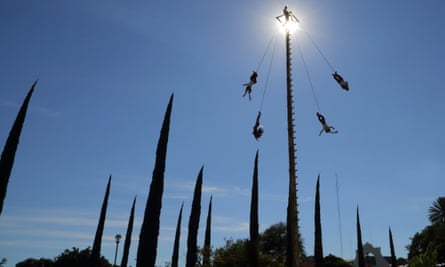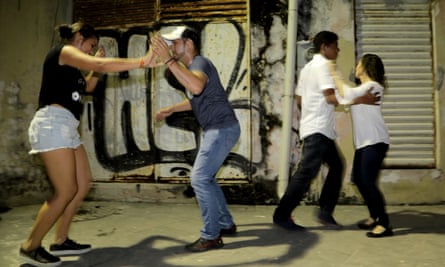I’m lying on the grass in the churchyard in Huaquechula, a small town in the state of Puebla, central Mexico. I open my eyes and look up. A man dressed in eagle feathers is standing on top of a 30-metre telegraph pole banging a small drum, and four other men are climbing up towards him. When the four reach the top, they attach ropes to their ankles and lean far back, arms out, until they are upside down. Then the eagle-man starts to dance and sing.
Huaquechula’s celebrations for the Day of the Dead are a thing of legend (it falls on 2 November, but the festivities actually last a week). Every year, as well as staging aerial displays in the churchyard, residents build elaborate altars to those who have died in the preceding 12 months. In some houses the altar fills the entire main room. Queues of visitors file past before heading into the yard to consume vast quantities of food and drink. In one house I find an old man sitting like some model for a Diego Rivera mural beside his deceased wife’s altar. “Her soul came during the night and drank a little cerveza michelada,” he says happily, pointing to a half-empty glass of salted beer.
In the churchyard the flying men start spinning around the pole. As they do so, the ropes on their ankles unwind from the top and they gently fly down to earth. In some places this strange trapeze act has become something of a tourist spectacle, but not here: this is still part of an ancient communal catharsis. As they touch down, the big crowd gives a heartfelt sigh. The living men have flown like eagles, like the souls of the dead ancestors, and are now safely back down. Life can continue.

But I’m not sure I can – continue, that is. I’m on a road trip across Mexico, heading east from Mexico City, then down the coast to finish at Los Tuxtlas biosphere reserve. Fermin, my guide and driver, is determined to show me places like this – real Mexico. In most places we are staying with indigenous people in their homes, seeing a side of Mexico rarely glimpsed by outsiders. The problem is, I feel very at home in Huaquechula, so much so that I never want to leave.
I tell Fermin I am going to settle here, wear a white linen suit and panama hat, and divide my time between learning to fly and drinking salty beer. He laughs and we clamber to our feet. An hour later we are on the road, heading north-east to the hillside town of Cuetzalan, where we walk through cobbled streets that seem little changed in centuries. Old ladies wear white embroidered smocks and carry their bags by forehead straps. In the town pharmacy the owner explains, mysteriously, that her father, founder of the business, used to get paid in snakes.

We stay in Taselotzin, a lovely guesthouse run by Doña Rufina, a formidable and charming woman from the Nawas indigenous community who has been fighting to keep young people interested in building lives here, not in the US. “Some men go and they never come back – just disappear,” she tells me.
Fermin and I retire to a bar filled with spooky wooden masks and drink dark herbal spirits from bottles with homemade labels. I hardly dare tell him, but Cuetzalan does seem like a town worth staying in for a long time.
Two days later we reach Veracruz, a major port. This time we stay in a hotel that looks out on the zócalo, the main square, where a band are warming up a crowd of locals who have come for the son jarocho, a local dance of delicate grace and beauty.

We head out and sit in a pavement cafe where we are immediately besieged by hustlers: shoeshines, palm-readers, peanut-sellers, kite-fliers, cigar-toting wristwatch purveyors, mariachi bands and women who sell chilli snacks that can melt human beings. There is even a man selling electric shocks. You test your machismo by holding on to two metal electrodes for as long as possible. Fermin is speechless from chilli snacks, but revives when attached to the electrodes.
Later we stroll through the port, watching courageous local lads dive for coins among the ships. Beyond that, another treat, a humming little barrio called La Huaca built from driftwood and packing crates where, at Samborcito restaurant, they serve the best cheese empanadas I’ve ever tasted. In Callejón de la Campana, we find a square packed with dancers and musicians. All the locals, it seems, from pequeños to pensioners, are out for the evening and performing sublime Latin moves.

You might think Veracruz would be a major tourist destination, but drug barons have, on occasion, fought their wars in its streets, while the administration is perpetually mired in crisis. Around my visit it was peaceful and a delight to explore, although the Foreign Office advice is to “take extra care”. Tourists are rarer than a foot out of place in a street rumba – at least until I attempt it.
Next morning we breakfast in Café del Portal, where waiters do astonishing things with coffee pots as they serve lechero – aerated coffee. I don’t want to leave Veracruz. When Fermin suggests we go, I say ahorita, a wonderful weasel word he had taught me. It means, literally, “right now”, but in fact means “probably never”. Fermin marches me to the car. We are driving to Catemaco, 170km south-east, he informs me, but with a stop in Tlacotalpan.
If Mexico seems to contain an inexhaustible supply of small magical towns, Tlacotalpan is the icing on the cake. Its long shady streets are filled with brightly painted colonial-era villas that were built with 18th-century timber money. We hire a couple of bicycles, the standard means of transport, and head off to meet Don Rafael Figueroa, an old friend of Fermin’s and the town’s musical instrument maker.
We pedal through the streets and come to a handsome house on the outskirts where the shutters are open and Fermin shouts inside: “Is the maestro at home?” To which comes the reply, “Which one?!” And then a smiling Don Rafael appears and welcomes us into a cool reception room furnished with rocking chairs.

As a younger man Don Rafael was a celebrated musician among the Latino community in the US, but now he has returned home to build the instrument he loves: the jarana, a type of diminutive eight-string guitar. Could we have a demonstration? He smiles and shouts into the workshop for assistance. Within a minute a band has gathered and, with Rafael on double bass, they romp through some classic rumba songs. A crowd gathers at the window. An old lady dances in the street as she passes. Don Rafael breaks off to chat to some young students who have arrived seeking tuition. He never refuses, and doesn’t charge. The man is a musical saint. I buy a handmade jarana from him. I fall in love with Tlacotalpan and decide never to leave.

Fermin eventually drags me away. “Trust me,” he says, with evangelical fervour, “the biosphere is worth it. You’ll like our next homestay host, Henry. It’s deep in the countryside – real Mexico!”
At nightfall we reach Catemaco, the gateway town for Los Tuxtlas, and eat moros y cristianos – the fanciest name for rice and beans I ever heard. In the streets, hustlers are advertising pirated goods and brujos – sorcerers. I turn to Fermin. Why are they advertising witches?
“Catemaco is famous for witchcraft. Everyone comes for it. Politicians are often here.”

In the morning we drive around the lake, eventually abandoning the tarmac for a red dirt road that leads us, finally, into the jungles of Los Tuxtlas biosphere reserve and to Henry’s house. His mother, Reina, greets us with a parrot on her shoulder. A hummingbird thrums past.
Henry is a large and lively man who has helped the small indigenous community of Benito Juárez to establish tourism. He takes me on a walk into the jungle that leads, eventually, to a vast grotto of basalt columns into which a huge waterfall thunders. I realise we are inside an ancient volcano now conquered by jungle.

Fifty years ago this land was all deforested, but Henry and the community have nurtured it back to health. The birds have returned and even the howler monkeys. Fermin was right, I realise: his road trip to show me real Mexico has worked. Everywhere we have visited or stayed with indigenous communities, but it has never seemed contrived or dulled by overly worthy intentions.
Next day I meet a man whose life has been transformed by tourism. His name, appropriately, is Lazaro. “I was farming all my life and making very little income,” he tells me. “Two years ago I went to a workshop where they told me people can make a living showing people birds. I couldn’t believe it! I have loved birds all my life and know all their names and where to see them.” Now he still farms, but is making good money from bird-guiding.


Comments (…)
Sign in or create your Guardian account to join the discussion